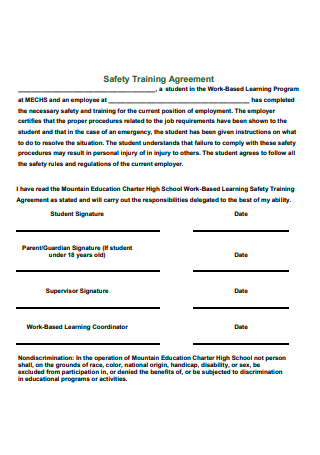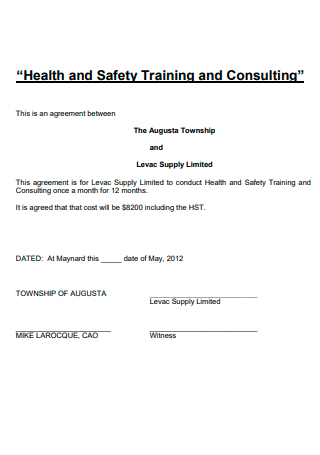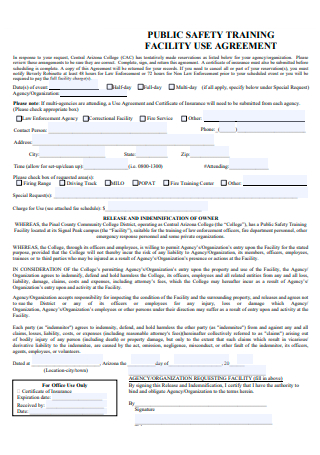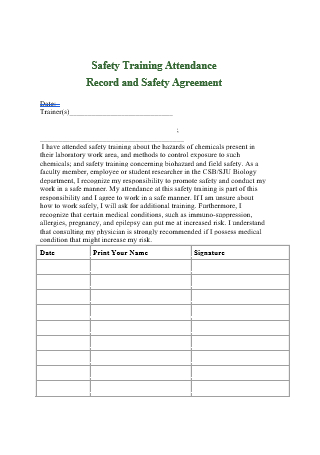A Sales Agreement is a vital legal document that outlines the terms and conditions of a transaction between a buyer and a seller. It defines the rights, obligations, and…
continue reading
4+ Sample Safety Training Agreement
What Is a Safety Training?
The term “safety training” refers to programs meant to educate personnel on preventative methods and procedures to reduce the danger of harm or death in the workplace. Safety training is a sort of compliance training designed to safeguard the company and its employees. According to the statistics, only 12% of women and 16% of males reported having safety training in the preceding year.
Benefits of Safety Training
It seems that anytime we discuss workplace safety in the present day, yells of “health and safety gone nuts!” follow shortly after. From prohibiting jogging at the playground to banning flip-flops in the office, discussions on the topic frequently center on circumstances when rules are at best absurd and at worst viewed as lacking common sense. With so much criticism and disagreement on the subject, it is easy to lose sight of why health and safety training is so vital. While it may be a common practice to poke fun at overzealous rules and regulations, we frequently overlook their essential role in safeguarding millions of UK employees from damage. Regardless of the size of your association, whether you have employees, health and safety should be your priority. Here are six fundamental reasons why safety training is essential for any organization.
Tips for Effective Training
We are all aware that safety training is crucial for numerous reasons. First, it prevents employees from performing unsafe and needless tasks; second, it reduces the frequency of accidents, sicknesses, and property damages. To achieve the best outcomes, we must focus on “effective” safety training rather than simply completing a course. We’ve compiled the top five tips for excellent safety training to assist you in enhancing your course’s results:
1. Identify the health concerns in the workplace first
To make a safety course effective, you must be aware of the risks involved. This offers your safety training adequate direction and makes it more focused, as identifying safety threats is a prerequisite to protecting employees. This is easily accomplished by conducting a job hazard assessment. You may read more about the distinction between a risk and a hazard.
2. Start controlling your workplace hazards
After you’ve found your health hazards, it’s always best to eliminate them, so employees don’t have to deal with them. If you can’t get rid of them, the next best thing is to control them. The hierarchy controls offer a way to keep hazards under control: Start by getting rid of things. Next, try a different word. Then it would help if you worked on designing controls. Fourth, try to control work practices. Last, you could try PPE.
3. Find out what your training goals are and focus on them
To effectively evaluate the effectiveness of your safety training course, you should develop a list of training objectives for cross-reference. This will not only direct your safety training, but it will also allow you to determine whether or not your employees profited from the session.
4. Comply with the safety training requirements
Always be aware of the safety regulations applicable to your site. This helps ensure compliance with the law. In addition, it establishes a baseline minimum or safety requirement level that must be met at all times.
5. See what your audience has learned by administering a test
Testing is the only definite way to decide whether your employees comprehend what they have studied. Ensure that they understand the principles and can implement them before sending them into the field. Additionally, testing will allow you to identify improvement areas for each employee.
How to Design a Safety Training For Employees
Employers should invest in safety training as a few crucial steps to prevent workplace property damage, injuries, and deaths. It aids in establishing a safety culture in which employees can promote proper safety procedures and prevent potential hazards. The Occupational Safety and Health Administration and the Government Labor Organization have established employee safety and health regulations in the United States. Therefore, an efficient safety training program must ensure compliance with all applicable standards and laws. You want your workers to complete tasks and fulfill their responsibilities safely and efficiently as an employer. If you search for efficient ways to build a safety training program for your employees, you have landed on the correct page. Here are the six most effective strategies to create a safety program for your employees:
Step 1: Assess The Training Requirements
The most effective way to begin planning a safety training program for your personnel is to consider whether or not the training will solve the situation. This stage is designed to help you determine your training requirements. Checking the current safety record of the company is a simple method for identifying such needs. This implies that you must establish whether the issue is related to employee performance in the workplace. In this scenario, training will be more successful when the issue is the performance of your personnel. When evaluating employees’ performance issues, it is essential to determine the nature of the problem and the most effective solution. For instance, if your employees experience back pain owing to low-quality office chairs, you may need to invest in chairs with unique ergonomic features and adjustments.
Step 2: Identify The Risks And Dangers In The Workplace
Your safety training program will be ineffective if you are unaware of the risks and hazards in the workplace. Knowing the dangers and threats in the workplace will help you to readily determine the training requirements necessary to close the knowledge gap. You can accomplish this by regularly evaluating the dangers and risks that are prevalent or unique to your workplace. It would benefit if you enabled employees to voice their risk-related concerns, as their input is precious. Since the employees work in these conditions daily, they can provide crucial information about a risk that may not be readily apparent to an inexperienced observer. You will also need to assess any additional potential safety risks that may surface along the way. However, it would help if you differentiated occupational hazards such as building layout from risks associated with machinery and environmental threats. This will guarantee that you establish an adequate safety training program to foster a safety culture among your personnel.
Step 3: Establish The Training Goals
After identifying the safety training requirements and the dangers and hazards in the workplace, you must establish practical learning objectives. Training experiences should align with your goals and aims for the effectiveness and functioning of safety training. The learning objectives are what you expect your employees to do on the job once the safety training is complete. Occasionally, goals can relate to knowledge, ability, behavior, or even method. Therefore, you must develop practical learning objectives that are lucid and quantifiable. This ensures that the training can be evaluated and revised in the future. In action-oriented language, your training objectives should also accurately describe the intended skill or behavior. The most significant benefit of specific safety training objectives is that they will assist you and your personnel comprehend the intended results.
Step 4: Create A Protocol For Your Staff
After deciding on the training goals, you need to make a plan for your employees. In the protocol, you should list all the ways your employees want to learn. The learning activities should help you reach all of the training goals and support the training goals. Your protocol should also list the training methods, materials, and other resources needed for practical workplace safety training. You must carefully choose the best materials, resources, and techniques. This will make sure that the message of the exercise gets across well. Whether you use a group or a person-to-person method, ensure it fits your audience and the skill or behavior you want to teach them. Learning activities could give employees a chance to show what they’ve learned and how good they are at it. They should be directly related to the job the person is doing.
Step 5: Execute The Plan
The training must be scheduled and conducted after creating the safety training plan. Training on safety should be given in a way that maximizes comprehension. Ideally, it would benefit if you began by presenting a training summary, so the staff knew what to expect. The training should also be relevant to the employee’s work experience for ease of application and relevancy. Following the completion of the safety training program, emphasize the lessons learned. If you struggle to keep your staff engaged and interested in learning, you can practice their new abilities alongside them during training. Keep in mind that active engagement and practical application increase the retention of further information.
Step 6: Evaluate And Modify The Instruction
A safety training program is only victorious if the objectives are met and the personnel learns from it. Therefore, the final step is to design a policy for evaluating the training, as its success cannot be determined without evaluation. You can solicit feedback from learners and utilize the assistance of supervisors who can evaluate employee behavior before and after training. The evaluation results will help you determine how to enhance safety training.
FAQs
What is a safety training program?
This course is intended to provide players with the basic information and skills for detecting safety, health, and environmental threats, selecting effective control methods and developing and executing Occupational Safety and Health (OSH) policies and programs.
What is safety training and education?
Education and training equip employers, managers, supervisors, and employees with the knowledge and skills necessary to perform their jobs safely and to prevent creating dangers that could put others at risk. Knowledge and comprehension of workplace dangers and how to identify, report, and control them.
What elements should a safety program contain?
Your company’s safety program should include safety plans, guidelines, and work practices for particular operations. The rules should consist of universally recognized and applied enforcement measures, such as disciplinary action or reorientation.
Outlining, creating, and structuring the agreement and the entire training program is not a simple task, as you must be careful not to overlook several concepts that may cause future problems. To secure everyone’s safety, though, is a commendable purpose. Do programs for the benefit of the majority without fear. What a fantastic profession you have!






